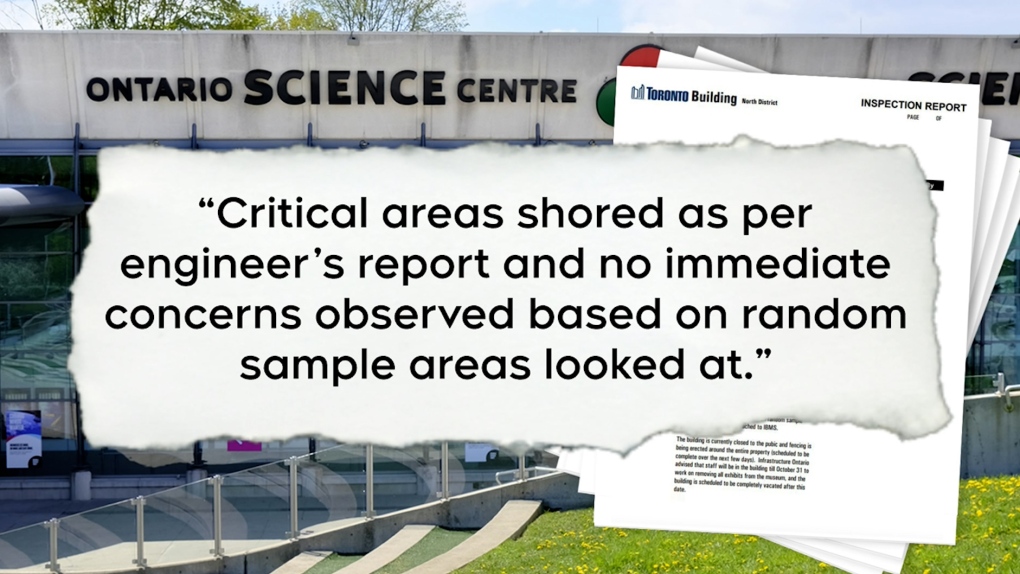On the day that the Ontario Science Centre was abruptly shuttered this summer, a city of Toronto staffer rushed to the building to inspect it – but didn’t mark down any immediate hazards, according to documents obtained by CTV News through a freedom of information request.
Instead, the inspector noted how the “critical” roof panels had already been secured, taking photos of the work that had been done, and visually inspecting the rest of the building, according to the records, which also detail an earlier effort by the Science Centre to fix a part of its roof.
“Critical areas shored as per engineer’s report and no immediate concerns observed based on random sample areas looked at,” wrote Inspector Brett Martin, according to the records.
That was the same day the Science Centre was dramatically shut down with just hours’ notice, with provincial government officials highlighting the potential danger of collapsing roof panels identified in an engineering report.
It turned out that the engineering report they relied on gave other options than closing the building, including cordoning off potentially unsafe areas. Critics, including the firm of the architect who designed the building, have said the building could be saved.
Responding to questions from CTV News in an unrelated news conference Wednesday, Infrastructure Minister Kinga Surma said the ministry was putting safety first.
“We knew that children were going to be within the building. We shared that information with the board, and the board made a decision to close the Science Centre down. It’s an unfortunate circumstance but we’re now working with the board on a new science centre and an interim location,” she said.
“We had to make sure that we prioritize the health and safety of the workers and the children and families that will be coming in and out of the building throughout the summer,” Surma said.
Around 50 science centre staff remain working in the Science Centre, packing up exhibits for storage. The building is planned to be fully evacuated by Oct. 31, 2024.
In a statement in July, Science Centre Board Chair John Carmichael and CEO Paul Kortenaar described the decision-making process this way: “Our Board of Trustees voted to close the building, based on a recommendation from the Ministry of Infrastructure and the CEO of the Science Centre.”

The City of Toronto documents detail applications to work on three different areas of the Science Centre: rerouting a kitchen hood fire suppression exhaust duct, replacing four doors, and fixing roof panels in the roof of the centre’s rainforest room that had become distressed because of moisture ingress.
The permit for the kitchen hood was granted in 2023, the records show, but the permit for the doors and the roof panels was still in progress by June 2024.
On June 3, a city examiner wrote to Infrastructure Ontario and a roofing contractor, saying, “Examination of your building permit application has revealed that certain requirements of the Ontario Building Code and/or other applicable By-laws have not been satisfied,” pointing to sections of the Conservation Authorities Act, the Ontario Heritage Act, and the Building Transit Faster Act.
On June 7, a city building engineer wrote to the same group, asking to provide it with a set of stamped drawings.
It’s not clear whether the agencies responded, and on the day the Science Centre was shut down, emails from city officials show there was no permit granted.
The emails show that city officials heard the building was closing as most of the public did: through the news media. They shared a CP24 news alert that described the building’s closure as breaking news, and Inspector Martin arrived on site at 6 p.m.
Elsa Lam of Canadian Architect Magazine said in an interview that the back and forth is typical of building permit applications and a sign that maintenance was going on in a building that was showing its age.
“Nobody was anticipating a closure to come this suddenly. It really came out of the blue,” she said, adding that the city inspector’s conclusion and observation that the critical panels were supported underscored the lack of real urgency that could have justified such a sudden shutdown.
“The urgent things were done, as they needed to be done, and there was no immediate danger…The closure was a completely political decision,” she said.





